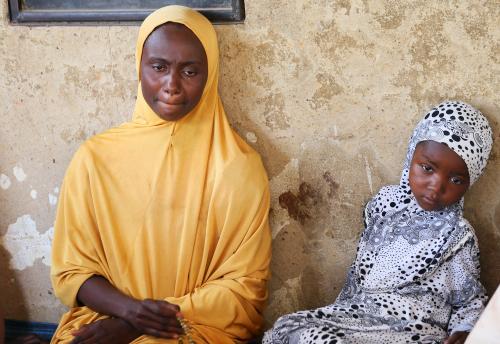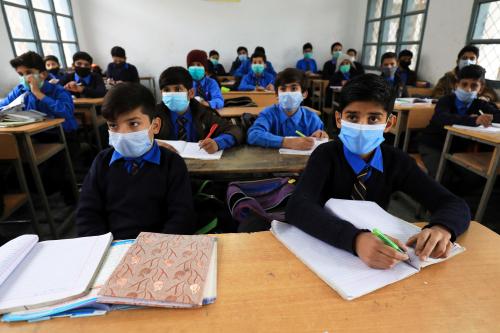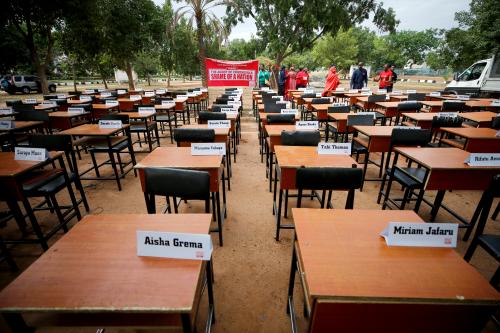In war, dedicated teachers are on the front lines of the battle for hope and equality. Facing harrowing conditions, teachers are often unsupported in their responses to the pleas of children and parents for access to meaningful education. The international community must also support these teachers and their students’ right to learn.
Attacks on schools are on the rise in places like Nigeria, Thailand and Syria, transforming schools from sanctuaries of learning to scenes of horror. “The same places we used to go to teach or to learn, the armed men take us there to torture us”, said an academic from Damascus University. Yet many teachers persist. In the Central African Republic, teachers take refuge with their students in bush schools in the forest. Here, there are no books or blackboards. Rather, enthusiasm and the will to learn bring education to life. In Afghanistan and Pakistan, female teachers defy daily threats and violence from extremists by educating the girls about whom they care so much.
Even as they risk their lives for their students by working under treacherous conditions, teachers in conflict-affected countries are mostly underpaid or, worse, not paid at all. In Lebanon, where 300,000 children are currently enrolled in public schools, there are now more than 500,000 additional school-age Syrian refugee children. Many teachers have gone from teaching classes of 40 students to working with classes of 90. Despite these and other challenges, teachers teach, children learn and healing begins. A young Somali refugee living in Nairobi said of his teachers: They “never miss a lesson in school, the teacher is there always on time, ready to teach us. The school has prepared me for the future.”
“Education cannot wait”, affirmed leaders last week during the U.N. General Assembly meetings. However, over 28 million children in 32 countries affected by conflict are waiting for education. A refugee teacher from the Democratic Republic of the Congo described arriving in Kampala, Uganda and finding no education available for refugee children. He remembered the words of his teacher, who had told him that, “If you arrive in the middle of a forest where there is no education, it is up to you to struggle to teach those children so that they will have something in their heads.” In this spirit, he started a school. “Even though there is no salary, even though there is no assistance, I still have, in my heart, this vocation.”
Children in conflict settings are not waiting on teachers. They are waiting on the international community. Despite the level of resolve and innovation shown by children, parents and teachers in conflict zones, education remains severely underfunded in humanitarian aid responses, slipping from 2 percent of total aid in 2009 to 1.4 percent in 2012, and consistently well under the 4 percent threshold called for by the international community.
Motivated by her firsthand experience of being shot for pursuing her right to education, 16-year-old Malala’s powerful message at the United Nations last week summed up the resolve of millions of children and youth like herself who are demanding change. She said, “Instead of sending guns, send pens. Instead of sending tanks, send books. Instead of sending soldiers, send teachers.”
Research is clear on at least three measures that would improve conditions for teachers and students in conflict-affected countries:
First, schools must be safe places. The Global Coalition to Protect Education from Attack has begun to create reporting systems for attacks against schools and to strengthen protection provisions for students and teachers. However, there remains work to do.
Second, teachers must be paid. Their role is too vital and their sacrifice too big not to be recognized formally. When a government is unable to pay teachers, funding for salaries should be integrated in humanitarian responses, along with funding for other vital aid workers. In Syria, small organizations provide incentive salaries for teachers, which allow them to continue teaching while supporting their own families.
Third, teachers need training. Whether they are experienced and working under severe conditions, or new teachers recruited to fill in for teachers who had to flee, all teachers require training that enables them to focus on essential learning and provide some level of psychosocial counseling to their students. The Inter-Agency Network on Education in Emergencies (a network of more than 9,500 practitioners around the world) has developed easily accessible guides to inform the design of teacher support systems.
Teachers are a central pillar of every peaceful society and even more so for societies weakened by war. A 20-year-old teacher in Aleppo, Syria teaches drawing classes to young children whose school has been destroyed. He said, “One of my students drew a vase with roses that are bleeding. I asked her: ‘What does it mean?’ She replied: ‘Syria represents these roses and it is bleeding and no one takes care of it.’ I have one wish in my life, it is for my country to be better than now with new hope for our children [so that] they draw the sun shining again in the sky.”
If supported, teachers can protect children from further harm—both psychological and physical. A former headmaster in Aleppo says, “We use all our efforts to make the children not think that life is different.” He and his colleagues have started schools in mosques, which represent a safer place for learning when public schools are targeted. “We collected the benches, old study books and whiteboards from the destroyed schools,” he said. “It is a great result to see the pupils come back to [their] desks with fantastic smiles.”
Let the courage of these teachers and the determination of the millions of children caught in conflicts and emergencies inspire the global community to act.
To paraphrase Malala: Instead of sending excuses, send investments. Instead of sending anguish, send action. Instead of sending despair, send hope.
The Brookings Institution is committed to quality, independence, and impact.
We are supported by a diverse array of funders. In line with our values and policies, each Brookings publication represents the sole views of its author(s).




Commentary
Instead of Sending Soldiers, Send Teachers
October 8, 2013